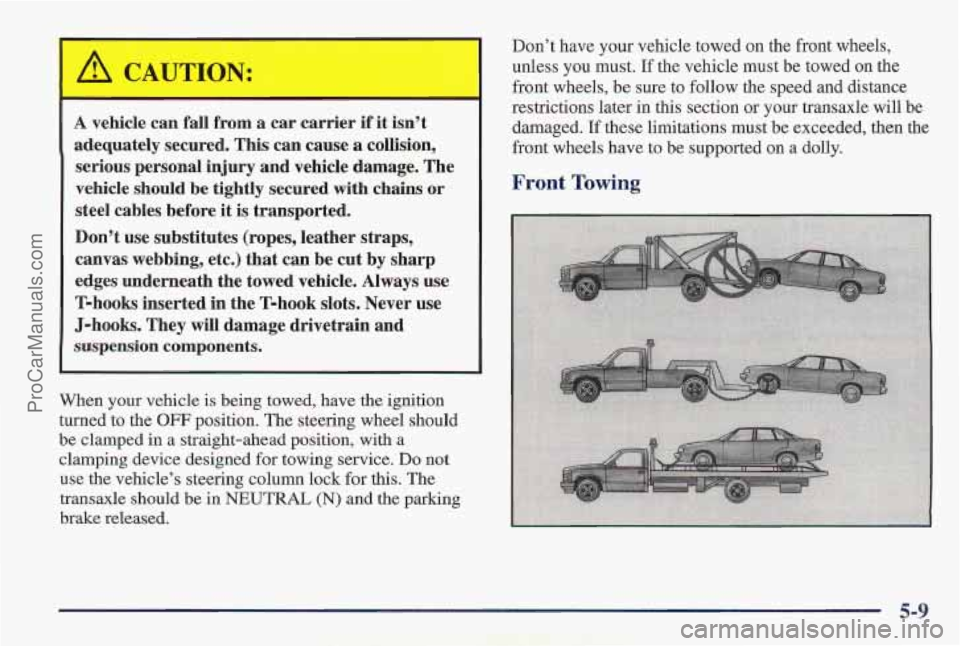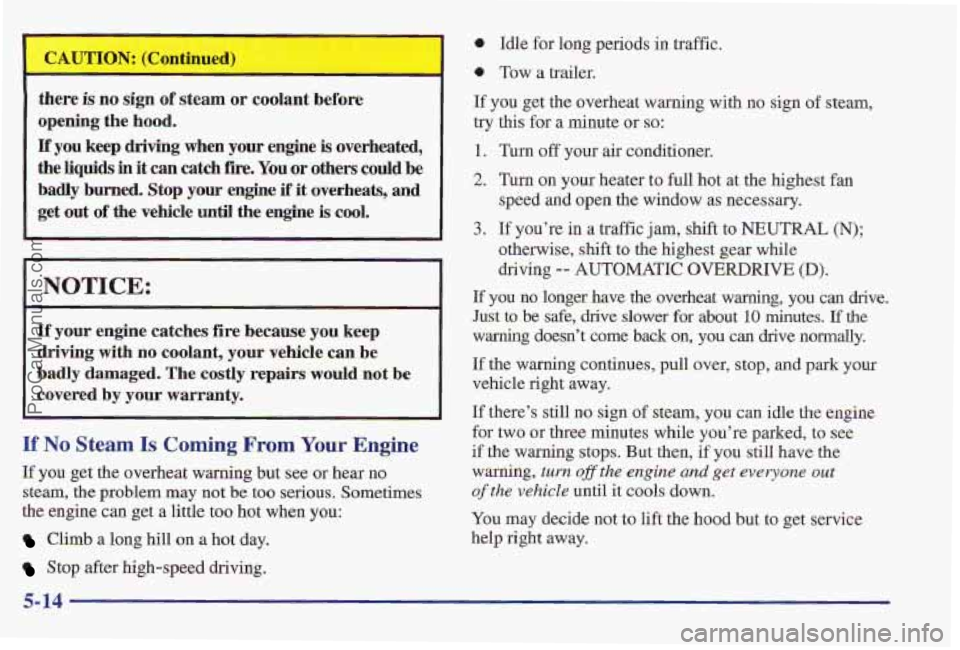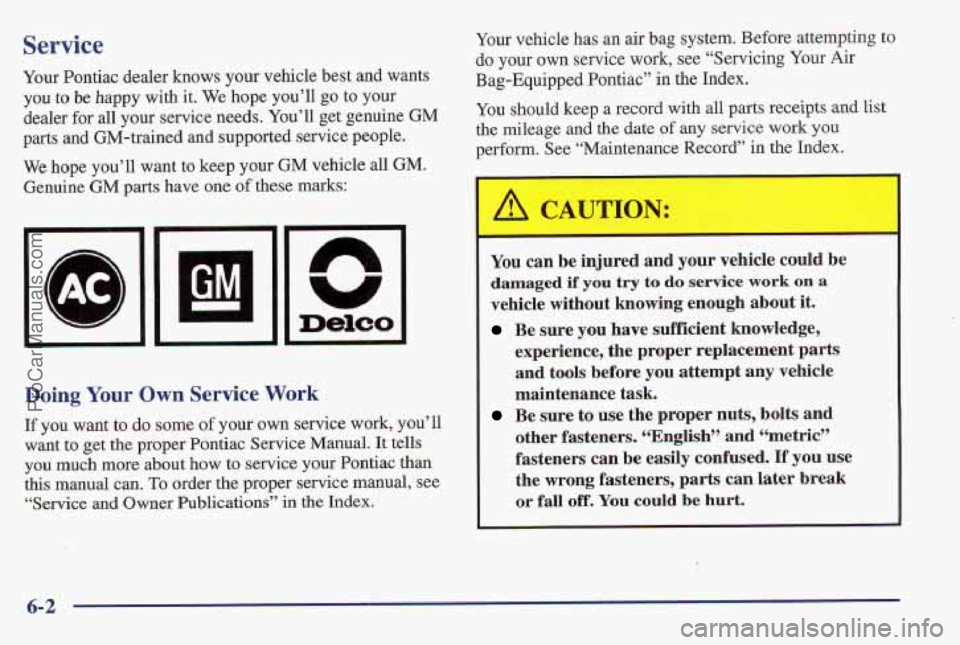1997 PONTIAC PONTIAC service
[x] Cancel search: servicePage 242 of 419

Towing Your Vehicle
Try to have a Pontiac dealer or a professional towing
service tow your vehicle.
If your vehicle has been changed or modified since it
was factory-new by adding aftermarket items like fog
lamps, aero skirting, or special tires and wheels, these
instructions and illustrations may not
be correct.
Before you
do anything, turn on the hazard
warning flashers.
When you call, tell the towing service:
That your vehicle cannot be towed from the front
with sling
type equipment.
0 That your vehicle has front-wheel drive.
0 The make, model, and year of your vehicle.
Whether you can still move the shift lever.
0 If there was an accident, what was damaged.
When the towing service arrives, let
the tow operator
know that this manual contains detailed towing
instructions and illustrations.
The operator may want
to see them.
r
I
To help avoid injury to you or others:
0 Never let passengers ride in a vehicle that is
Never tow faster than safe or posted speeds.
Never tow with damaged parts not fully secured.
Never get under your vehicle after it has
been lifted by the tow truck.
Always secure the vehicle on each side with
separate safety chains when towing it.
Never use J-hooks. Use T-hooks instead.
being towed.
5-8
ProCarManuals.com
Page 243 of 419

,-., ., . ........
A vehicle can fall from a car carrier if it isnst" .,''.' ''.
adequately secured. This can cause a collision,
serious personal injury and vehicle damage. The
vehicle should be tightly secured
with chains or
steel cables before
it is transported.
Don't use substitutes (ropes, leather straps,
canvas webbing, etc.) that can be cut by sharp
edges underneath the towed vehicle. Always use
T-hooks inserted in the T-hook slots. Never use
J-hooks. They will damage drivetrain and
suspension components.
When your vehicle is being towed, have the ignition
turned to the
OFF position. The steering wheel should
be clamped in
a straight-ahead position, with a
clamping device designed for towing service.
Do not
use the vehicle's steering column lock for this. The
transaxle should be in
NEUTRAL (N) and the parking
brake released. Don't have your vehicle towed on the front
wheels,
unless you must.
If the vehicle must be towed on the
front wheels,
be sure to follow the speed and distance
restrictions later in this section or your transaxle will be
damaged.
If these limitations must be exceeded, then the
front wheels have to be supported
on a dolly.
Front Towing
ProCarManuals.com
Page 248 of 419

tnere is no sign of steam or coolant before
opening the hood.
If you keep driving when your engine is overheated,
the
liquids in it can catch fire. You or others could be
badly burned. Stop your engine if it overheats, and
get out
of the vehicle until the engine is cool.
I NOTICE:
If your engine catches fire because you keep
driving
with no coolant, your vehicle can be
badly damaged. The costly repairs would not
be
covered by your warranty.
If No Steam Is Coming From Your Engine
If you get the overheat warning but see or hear no
steam, the problem may not be too serious. Sometimes
the engine can get a little
too hot when you:
Climb a long hill on a hot day.
Stop after high-speed driving. Idle for long
periods in traffic.
* Tow a trailer.
If you get the overheat warning with no sign of steam,
try this for a minute or so:
1. Turn off your air conditioner.
2. Turn on your heater to full hot at the highest fan
speed and open the window as necessary.
3. If you’re in a traffic jam, shift to NEUTRAL (N);
otherwise, shift to the highest gear while
driving
e- AUTOMATIC OVERDRIVE (D).
If you no longer have the overheat warning, you can dnve.
Just to be safe, drive slower for about 10 minutes. If the
warning doesn’t come back on, you can drive normally.
If the warning continues, pull over, stop, and park your
vehicle right away.
If there’s still no sign of steam, you can idle the engine
for two or three minutes while you’re parked, to see
if the warning stops. But then, if you still have the
warning, turn off the engine and get everyone out
of the vehicle until it cools down.
You may decide not to lift the hood but to get service
help right away.
5-14
ProCarManuals.com
Page 251 of 419

NOTICE:
Engine damage from running your engine
without coolant isn’t covered
by your warranty.
_I
If there seems to be no leak, with the engine on, check to
see if the electric engine fans are running.
If the engine
is overheating and the key
is on, both fans should be
running. If they aren’t, your vehicle needs service.
How to Add Coolant to the Coolant
Recovery Tank
If you haven’t found a problem yet, but the coolant level
isn’t at the
COLD mark, add a 50/50 mixture of clean
water (preferably distilled) and DEX-COOL
antifreeze at the coolant recovery tank. (See “Engine
Coolant” in the Index for more information.)
Adding only plain water to your cooling system
can be dangerous. Plain water, or some other
liquid like alcohol, can boil before the proper
coolant mix will. Your vehicle’s coolant warning
system is set for the proper coolant
mix.
With plain water or the wrong mix, your engine
could get too hot but you wouldn’t get the
overheat warning. Your engine could catch
fire
and you or others could be burned. Use a 50/50
mix of clean water and DEX-COOL antifreeze.
I NOTICE:
In cold weather, water can freeze and crack the
engine, radiator, heater core and other parts.
Use the recommended coolant and the proper
coolant mix.
ProCarManuals.com
Page 271 of 419

Section 6 Service and Appearance Care
Here you will find information about the care of your Pontiac. This section begins with service and fuel information,
and then it shows how to check important fluid and lubricant levels. There
is also technical information about your
vehicle, and a part devoted to its appearance care.
6-2
6-3 6-5
6-5
6-7
6- 14
6-2 1
6-26
6-32
6-33 6-36
6-37
6-37 6-44
6-46
Doing Your Own Service Work
What Kind of Fuel to Use
Using Fuel in Foreign Countries
Where to Put the Fuel and Filling the Tank
Checking
Things Under the Hood
Checking Your Engine Oil
Automatic Transaxle Fluid
Engine Coolant
Where to Fill the Windshield Washer Fluid
Important Brake Information
Information on Your Vehicle’s Battery
Tips on Vehicle Storage
Bulb Replacement Procedures
Windshield Wiper Blade Replacement
How and When to Check Tire Inflation 6-50
6-52
6-55
6-58
6-59
6-61
6-63
6-64
6-65 6-66
6-66
6-72
6-72
6-73
6-73 When
it is Time to Buy New Tires
Wheel Alignment
Cleaning the Inside of Your Vehicle
Care of the Safety Belts and Built-in
Child Restraint
Cleaning the Outside of Your Vehicle
How to Clean Aluminum Wheels
Underbody Maintenance
Recommended Appearance
Care Materials
Your Vehicle Identification Number (VIN)
The Electrical System
Fuses and Circuit Breakers
Replacement Bulb Types for Your Vehicle
Capacities and Specifications
Air Conditioning Specifications
Normal Replacement Parts
ProCarManuals.com
Page 272 of 419

Service
Your Pontiac dealer knows your vehicle be,st and wants
you
tu be happy with it. We hope you’ll go to your
dealer
for all your service needs. You’ll get genuine GM
parts and GM-trained and supported service people.
We hope you’ll want to keep
your GM vehicle all GM.
Genuine GM parts have one of these marks:
Deleo
-.
Doing Your Own Service . hrk
~~
If you want to do some of your own service work, you’ll
want
to get the groper Pontiac Service Manual. It tells
you
much more about how to service your Pontiac than
this manual can.
To order the proper service manual, see
“Service and O’wner
Publications” in the Index. Your
vehicle
has an air bag system. Before attempting to
do your own sewice work, see “Servicing Your Air
Bag-Equipped Pontiac”
in the Index.
You should keep a record with all parts receipts and list
the mileage and the date of any service work you
perform, See “Maintenance Record” in the Index,
You can be injured and your vehicle could be
damaged if you try to do service work on a
vehicle without knowing enough about it.
Be sure you have sumcient knowledge,
experience, the proper replacement parts
and tools before you attempt any vehicle
maintenance
task.
Be sure to use the proper nuts, bolts and
other fasteners. C‘English” and (‘metric”
fasteners can be easily confused,
If you use
the wrong fasteners, parts can
later break
or fall off. You could be hurt.
6-2
ProCarManuals.com
Page 273 of 419

Adding Equipment to the Outside of
Your Vehicle
Things you might add to the outside of your vehicle can
affect the airflow around it. This may cause wind noise
and affect windshield washer performance. Check with
your Pontiac dealer before adding equipment to the
outside of your vehicle.
Fuel
The 8th digit of your vehicle identification number
(VIN) shows the code letter for your engine. You will
find the VIN at the top left
of your instrument panel.
(See “Vehicle Identification Number” in the Index.)
If you have the 3800 engine (VIN Code K), use regular
unleaded gasoline rated at 87 octane or higher. If you’re
using fuel rated at the recommended octane or higher
and you still hear heavy knocking, your engine needs
service. But don’t worry if you hear a little pinging
noise when you’re accelerating or driving up a hill.
That’s normal, and you don’t have to buy a higher
octane fuel to get rid of pinging. It’s the heavy, constant
knock that means you have
a problem.
If you have the 3800 Supercharged engine (VIN Code
l), use premium unleaded gasoline rated at 91 octane or
higher. With
the 3800 Supercharged engine, in an
emergency, you may be able
to use a lower octane -- as
low as 87
-- if heavy knocking does not occur. If you
are using 91 or higher octane unleaded gasoline and you
still hear heavy knocking, your engine needs service.
At
a minimum, the gasoline you use should meet
specifications ASTM D48
14 in the United States an’d
CGSB 3.5-M93 in Canada. Improved gasoline
specifications have been developed by the American
Automobile Manufacturers Association (AAMA) for
better vehicle performance and engine protection.
Gasolines meeting the AAMA specification could
provide improved driveability
and emission control
system protection compared to other gasolines.
Be sure the posted octane for premium is at least 91 (at
least 89 for middle grade and
87 for regular). If the
octane is less than 87, you may get a heavy knocking
noise when you drive.
If it’s bad enough, it can damage
your engine.
ProCarManuals.com
Page 274 of 419

If your vehicle is certified to meet California Emission
Standards (indicated on the underhood tune-up label),
it
is designed to operate on fuels that meet California
specifications. If such fuels
are not available in states
adopting California emissions standards, your vehicle
will operate satisfactorily on fuels
meeting federal
specifications, but emission control system performance
may be affected. The malfunction indicator lamp
on
your instrument panel may turn on and/or your vehicle
may fail a smog-check test.
If this occurs, return to your
authorized Pontiac dealer for diagnosis to determine
the
cause of failure. In the event it is determined that the
cause of
the condition is the type of fuels used, repairs
may not be covered by your warranty.
Some gasolines that
are not reformulated for low
emissions contain an octane-enhancing additive called
methylcyclopentadlenyl manganese tricarbonyl (MMT); ask your service station operator whether or not his fuel
contains
MMT. General Motors does not recommend the
use of such gasolines. If fuels containing MMT are used,
spark plug life may be reduced and your ernissicrn
control
system performance may be affected. The
malfunction indicator lamp
on your instrument panel
may
turn on. If this occurs, return to your authorized
Pontiac dealer
€or service.
To provide cleaner ais, all gasolines in the United States
are now required to contain additives that will help
prevent deposits
from forming in your engine and fuel
system, allowing your emission control system to
function properly. Therefore,
you should not have to add
anything to the
fuel. In addition, gasolines containing
oxygenates, such as ethers and ethanol, and
reforrnulate'd gasolines may
be available in your area to
help clean the air. General Motors recommends that you
use these gasolines
if they comply with the
specifications described earlier.
~~
NOTICE:
Your vehicle was not designed for fuel that
contains methanol. Don't use it. It
can corrode
metal parts in
your fuel system and also damage
plastic and
rubber parts. That damage wouldn't
be covered under
your warranty.
_____~~
6-4
ProCarManuals.com